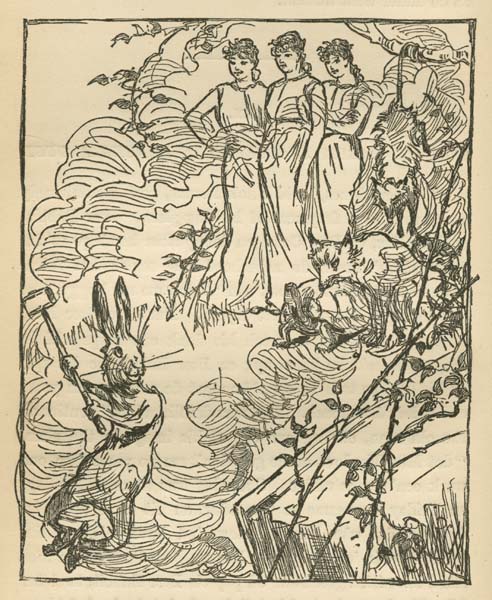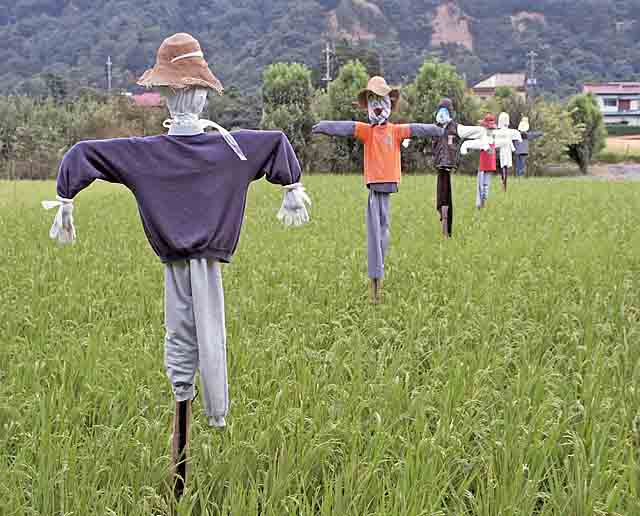|
Sang Kancil
The stories of Sang Kancil is a series of traditional fables about a clever mouse-deer. They are popular in Indonesia and Malaysia. A weak and small yet cunning figure, Sang Kancil uses his intelligence to triumph over beings more powerful than himself. The protagonist of these stories is Sang Kancil, a smart and sly mouse deer. He can fool the other animals to escape from trouble. This folk figure is similar to another folk figure, Br'er Rabbit. Sang Kancil and the Farmer One day, Sang Kancil is trying to steal cucumbers from a farmer's field. The first time, he steals some cucumbers successfully. He then encounters a scarecrow, and he mocks it because it cannot scare him. He kicks the scarecrow with his front leg, but his front leg gets stuck in the scarecrow, which has been filled with glue by the farmer. He tries to pull out his leg, but in vain as the glue is too strong for him to pull out his leg. Later, the farmer comes and laughs at Sang Kancil, who has been trapped by the ... [...More Info...] [...Related Items...] OR: [Wikipedia] [Google] [Baidu] |
Fable
Fable is a literary genre: a succinct fictional story, in prose or verse (poetry), verse, that features animals, legendary creatures, plants, inanimate objects, or forces of nature that are Anthropomorphism, anthropomorphized, and that illustrates or leads to a particular moral lesson (a "moral"), which may at the end be added explicitly as a concise maxim (philosophy), maxim or saying. A fable differs from a parable in that the latter ''excludes'' animals, plants, inanimate objects, and forces of nature as actors that assume speech or other powers of humankind. Conversely, an animal tale specifically includes talking animals as characters. Usage has not always been so clearly distinguished. In the King James Version of the New Testament, "" ("''mythos''") was rendered by the Translation, translators as "fable" in the First Epistle to Timothy, the Second Epistle to Timothy, the Epistle to Titus and the First Epistle of Peter. A person who writes fables is a fabulist. History T ... [...More Info...] [...Related Items...] OR: [Wikipedia] [Google] [Baidu] |
Lesser Mouse-deer
The lesser mouse-deer, lesser Malay chevrotain, or kanchil (''Tragulus kanchil'') is a species of even-toed ungulate in the family Tragulidae. Distribution The lesser mouse-deer is found widely across Southeast Asia in Indochina, Myanmar (Kra Isthmus), Brunei, Cambodia, China (Southern Yunnan), Indonesia (Kalimantan, Sumatra and many other small islands), Laos, Malaysia (Peninsular Malaysia, Sarawak and many other small islands), Singapore, Thailand, and Vietnam. Description It is one of the smallest known hoofed mammals, its mature size being as little as 45 cm (18 inches) and 2 kg (4.4 lb) and related to the even smaller Java mouse-deer. It is threatened by predation by feral dogs. Through further research it is also discovered that the creatures who were initially believed to be nocturnal actually conduct their activities during the day. As discovered by Kusuda, the first being that though many births occur in May, November or December, the females are able ... [...More Info...] [...Related Items...] OR: [Wikipedia] [Google] [Baidu] |
Indonesia
Indonesia, officially the Republic of Indonesia, is a country in Southeast Asia and Oceania between the Indian and Pacific oceans. It consists of over 17,000 islands, including Sumatra, Java, Sulawesi, and parts of Borneo and New Guinea. Indonesia is the world's largest archipelagic state and the 14th-largest country by area, at . With over 275 million people, Indonesia is the world's fourth-most populous country and the most populous Muslim-majority country. Java, the world's most populous island, is home to more than half of the country's population. Indonesia is a presidential republic with an elected legislature. It has 38 provinces, of which nine have special status. The country's capital, Jakarta, is the world's second-most populous urban area. Indonesia shares land borders with Papua New Guinea, East Timor, and the eastern part of Malaysia, as well as maritime borders with Singapore, Vietnam, Thailand, the Philippines, Australia, Palau, and India ... [...More Info...] [...Related Items...] OR: [Wikipedia] [Google] [Baidu] |
Malaysia
Malaysia ( ; ) is a country in Southeast Asia. The federation, federal constitutional monarchy consists of States and federal territories of Malaysia, thirteen states and three federal territories, separated by the South China Sea into two regions: Peninsular Malaysia and Borneo's East Malaysia. Peninsular Malaysia shares a land and maritime Malaysia–Thailand border, border with Thailand and Maritime boundary, maritime borders with Singapore, Vietnam, and Indonesia. East Malaysia shares land and maritime borders with Brunei and Indonesia, and a maritime border with the Philippines and Vietnam. Kuala Lumpur is the national capital, the country's largest city, and the seat of the Parliament of Malaysia, legislative branch of the Government of Malaysia, federal government. The nearby Planned community#Planned capitals, planned capital of Putrajaya is the administrative capital, which represents the seat of both the Government of Malaysia#Executive, executive branch (the Cabine ... [...More Info...] [...Related Items...] OR: [Wikipedia] [Google] [Baidu] |
Br'er Rabbit
Br'er Rabbit (an abbreviation of ''Brother Rabbit'', also spelled Brer Rabbit) is a central figure in an oral tradition passed down by African-Americans of the Southern United States and African descendants in the Caribbean, notably Afro-Bahamians and Turks and Caicos Islanders. He is a trickster who succeeds by his wits rather than by brawn, provoking authority figures and bending social mores as he sees fit. Popularly known adaptations of the character was originally written by Joel Chandler Harris in the 19th century, and later by Walt Disney Productions adapted it for the film ''Song of the South'' in 1946. __TOC__ African origins The Br'er Rabbit stories can be traced back to trickster figures in Africa, particularly the hare that figures prominently in the storytelling traditions in West, Central, and Southern Africa. Among the Temne people in Sierra Leone, they tell children stories of a talking rabbit. Other regions of Africa also tell children stories of talki ... [...More Info...] [...Related Items...] OR: [Wikipedia] [Google] [Baidu] |
Cucumbers
Cucumber (''Cucumis sativus'') is a widely-cultivated creeping vine plant in the Cucurbitaceae family that bears usually cylindrical fruits, which are used as culinary vegetables.Cucumber " '' Encyclopædia Britannica''. 9982019. Considered an annual plant, there are three main varieties of cucumber—slicing, pickling, and seedless—within which several cultivars have been created. ... [...More Info...] [...Related Items...] OR: [Wikipedia] [Google] [Baidu] |
Scarecrow
A scarecrow is a decoy or mannequin, often in the shape of a human. Humanoid scarecrows are usually dressed in old clothes and placed in open fields to discourage birds from disturbing and feeding on recently cast seed and growing crops.Lesley Brown (ed.). (2007). "Shorter Oxford English Dictionary on Historical Principles". 6th ed. Oxford: Oxford University Press. . Scarecrows are used around the world by farmers, and are a notable symbol of farms and the countryside in popular culture. Design The common form of a scarecrow is a humanoid figure dressed in old clothes and placed in open fields to discourage birds such as crows or sparrows from disturbing and feeding on recently cast seed and growing crops. Machinery such as windmills have been employed as scarecrows, but the effectiveness lessens as animals become familiar with the structures. Since the invention of the humanoid scarecrow, more effective methods have been developed. On California farmland, highly-reflectiv ... [...More Info...] [...Related Items...] OR: [Wikipedia] [Google] [Baidu] |
Crocodiles
Crocodiles (family Crocodylidae) or true crocodiles are large semiaquatic reptiles that live throughout the tropics in Africa, Asia, the Americas and Australia. The term crocodile is sometimes used even more loosely to include all extant members of the order Crocodilia, which includes the alligators and caimans (family Alligatoridae), the gharial and false gharial (family Gavialidae) among other extinct taxa. Although they appear similar, crocodiles, alligators and the gharial belong to separate biological families. The gharial, with its narrow snout, is easier to distinguish, while morphological differences are more difficult to spot in crocodiles and alligators. The most obvious external differences are visible in the head, with crocodiles having narrower and longer heads, with a more V-shaped than a U-shaped snout compared to alligators and caimans. Another obvious trait is that the upper and lower jaws of the crocodiles are the same width, and the teeth in the lower jaw ... [...More Info...] [...Related Items...] OR: [Wikipedia] [Google] [Baidu] |
Indonesian Folklore
Folklore of Indonesia is known in Indonesian as ''dongeng'' (), ''cerita rakyat'' () or ''folklor'' (), refer to any folklore found in Indonesia. Its origins are probably an oral culture, with a range of stories of heroes associated with wayang and other forms of theatre, transmitted outside of a written culture. Folklore in Indonesia are closely connected with mythology. Themes Indonesian folklore reflects the diverse culture of Indonesia as well as the diversity of ethnic groups in Indonesia. Many ethnic groups have their own collection of tales and folklores that have been told for generations. The stories are usually told to children as bedtime stories, and have pedagogical values such as kindness, benevolence, modesty, honesty, bravery, patience, persistence, virtue, and morality. For example, one popular theme is "the truth will always prevail, and evil will always be defeated." While most Indonesian folkloric stories have happy endings and 'happily ever after' themes ... [...More Info...] [...Related Items...] OR: [Wikipedia] [Google] [Baidu] |
Malaysian Folklore
Malaysian may refer to: * Something from or related to Malaysia, a country in Southeast Asia * Malaysian Malay, a dialect of Malay language spoken mainly in Malaysia * Malaysian people, people who are identified with the country of Malaysia regardless of their ethnicities. Most Malaysians are of Malay, Chinese and Indian descent. ** Malaysian diaspora, Malaysian emigrants and their descendants around the world * Malaysian cuisine, the food and food culture of Malaysia * Malaysian culture, culture associated with Malaysia * The call sign and colloquial name of Malaysia Airlines Malaysia Airlines Berhad (MAB; ms, Penerbangan Malaysia Berhad), formerly known as Malaysian Airline System (MAS; ), and branded as Malaysia Airlines, is the flag carrier airline of Malaysia and a member of the Oneworld airline alliance. (Th ... See also * Malaysian names, names as used by the Malaysian people * * * Malays (other) * Malaya (other) * Malay (other) ... [...More Info...] [...Related Items...] OR: [Wikipedia] [Google] [Baidu] |
Fictional Deer And Moose
Fiction is any creative work, chiefly any narrative work, portraying individuals, events, or places that are imaginary, or in ways that are imaginary. Fictional portrayals are thus inconsistent with history, fact, or plausibility. In a traditional narrow sense, "fiction" refers to written narratives in prose often referring specifically to novels, novellas, and short stories. More broadly, however, fiction encompasses imaginary narratives expressed in any medium, including not just writings but also live theatrical performances, films, television programs, radio dramas, comics, role-playing games, and video games. Definition Typically, the fictionality of a work is publicly marketed and so the audience expects the work to deviate in some ways from the real world rather than presenting, for instance, only factually accurate portrayals or characters who are actual people. Because fiction is generally understood to not fully adhere to the real world, the themes and context o ... [...More Info...] [...Related Items...] OR: [Wikipedia] [Google] [Baidu] |





